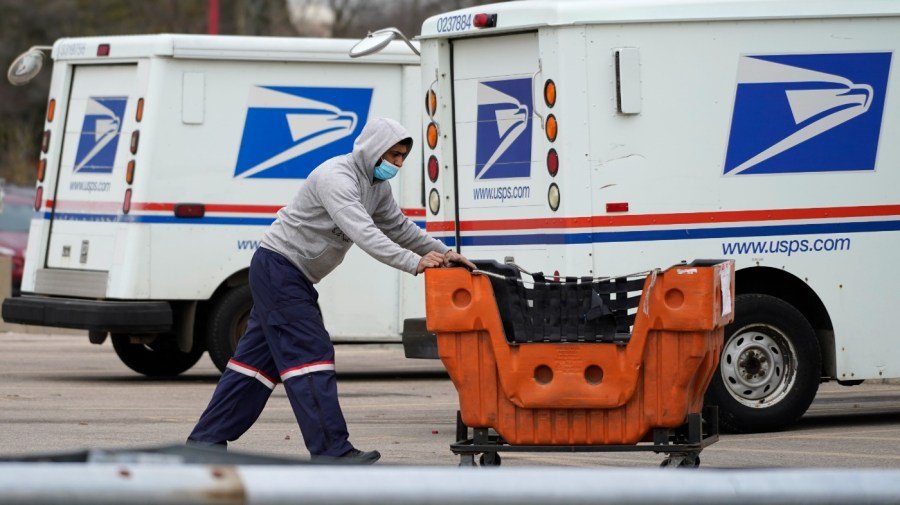A recent poll shows what DOGE is up against and why it must succeed.
Gallup found that among 15 government agencies, the U.S. Postal Service is the only one with majority support. Yet, USPS is a poster child of financial failure and inefficiency, thanks to its government monopoly and subsidy. It is also a microcosm of what DOGE faces and what the left will do with government if allowed.
According to Gallup, “the Postal Service has been the most highly rated agency, or among the highest, since it was first included in Gallup’s periodic government agency assessments in 2014.” The irony of this public assessment is USPS’s performance assessment.
USPS had 525,469 career and 115,000 non-career employees in 2024. Its 2024 report to Congress revealed that “the net loss for the year under generally accepted accounting principles totaled $9.5 billion, compared to a net loss of $6.5 billion for the prior year.” This was against “total operating revenue” of just $79.5 billion — “an increase of $1.4 billion, or 1.7 percent, compared to the prior year.” In five of its six operating categories, volume decreased from 2023.
In August 2023, the Government Accountability Office released “a harsh critique of the Postal Service and its efforts thus far to implement a 10-year strategic plan aimed at improving performance and turning around mounting losses that run against a government mandate for the USPS to be self-sustaining.”
It also noted that “the USPS has not been able to cover its debt and expenses for 15 years.” Make that 16 years now.
As a comparison, USPS’s private sector counterpart, UPS, had 500,000 employees, a revenue of $90.7 billion, and a market cap of $105.6 billion. It had 2024 earnings of $7.4 billion, down from 2023’s $8.6 billion. It has not suffered a loss even once this century.
How can the dichotomy between USPS perception and performance exist? The answer is government monopoly and subsidy. The “monopoly over the carriage of letter-mail” is granted by what is known as the Private Express Statutes. The subsidy comes from the general taxpayer, who pays for USPS’s latest $9.5 billion loss.
The monopoly is important. By looking at the parcel delivery service, we can see what would happen without it: the private sector competition would drive down USPS volume even further than the 3.2 percent drop from 2023.
Yet as USPS’s drop in volume shows, monopoly alone is not enough. It needs the government’s subsidy too. Again, if the public had to pay the full cost USPS incurs to deliver its mail, volume would drop even more.
What’s more, public perception of USPS would undoubtedly plunge with it. Monopoly and subsidy together bolster the public’s perception — or rather, misperception — of USPS’s performance. Having no alternative, consumers must use it. And not having to pay its actual cost, they do not recognize its poor performance.
USPS is a case study of the insidious nature of government monopoly and subsidy. The Austrian economist Ludwig von Mises encapsulated the economic fallacy of the consequences of the absence of the free market’s price system. Absent a freely determined price system, subsidization inevitably arises; government-assigned values either over- or under-compensate producer and consumer, which leads to over- or under-production or over- or under-consumption of a good or service.
Subsidization is an inescapable outgrowth of centralized decision-making replacing freely determined prices. The factors of supply and demand simply move too quickly for bureaucratic decision-making, only a constantly adjusting market can capture these.
And only a monopoly can enforce the continued subsidization because no one is willing to subsidize another’s windfall, and no one willingly submits to the inefficiency that subsidized allocation results in.
Both explain the USPS’s continued poor performance (as demonstrated by its continued decline in volume) and financial failure (as evidenced by its record of losses). They also show what the Trump administration’s DOGE faces.
USPS is a microcosm of federal government inefficiency, deficits, and debt. In total, according to the Congressional Budget Office, the federal government spent $6.8 trillion in FY 2024 (23.4 percent of America’s GDP), ran a $1.8 trillion deficit (6.4 percent of GDP), and left debt held by the public at 97.8 percent of GDP.
If this unsustainable trajectory continues, in 2054, as a percentage of GDP, federal spending will be 27.3 percent, deficits will be 8.5 percent and debt will be 179 percent. Nor does this capture federal regulations’ costs, which are invisible taxes because their costs to the private sector are uncalculated.
USPS is also a microcosm of what the left wants the federal government to do. Medicare for All, the left’s latest version of socialized medicine, would combine the efficiency of the USPS with the bedside manner of the IRS.
Finally, USPS is also an object lesson on why DOGE must proceed and why it is long overdue.
J.T. Young is the author of the new book, “Unprecedented Assault: How Big Government Unleashed America’s Socialist Left,” from RealClear Publishing. He has more than three decades’ experience working in Congress, the Department of Treasury, and OMB, and representing a Fortune 20 company.


